|
1) How do you prefer to be described within the field of textile
history?
If you have a business, please tell us
about that.
“Quilt magnet: collector, writer, blogger, photographer, and budding
historian.”
2) When and where did you begin your serious interest in the
history of quilts, textiles or garments?
“I’ve always been
interested in art and antiques. When I was a graduate student in
photography living in New York City in 1989, I was dating a young
lady from Germany who was in New York studying under a Fulbright
Grant. She’d heard about the tradition of quilt making in America,
and wanted to buy an old patchwork quilt to bring home to Germany.
One day she brought me to a private showing of antique American
quilts. The showing was in an upscale, uptown brownstone apartment,
and there were beautiful old quilts draped all over the furniture. A
nice lady who was bursting with passion about quilts greeted us. It
was Shelly Zegart.
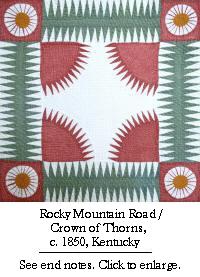
"That day, I spotted a spectacular, densely quilted red, white and
green quilt, which Shelly called a "New York Beauty" It stood out
from the rest. I found myself obsessed with it, but couldn’t afford
it. Shelly could see I loved it, so she offered to hold it for me,
and allowed me to pay in installments. Several months later, I owned
my first quilt.
"For years, I viewed quilts primarily as art, and would hang them in
my home as wall décor. I was only casually interested in the
history. Between 1989 and 2009, I bought more quilts. Every so
often, I would visit a local guild such as the Northwest Quilters,
or would loan a quilt for a show. I’d even visited Latimer Quilt and
Textile Center to show a group of quilts to board members and offer
to loan quilts. Even though I made these occasional efforts to share
quilts, I remained very much under everyone’s radar.
"In 2009, around the time I left my job as a magazine editor and
journalist, I heard about the Columbia-Willamette Quilt Study Group,
and contacted Mary Bywater Cross and Martha Spark to introduce
myself. I thought maybe I’d join the group and bring quilts for show
and tell. Mary and Martha seemed interested in my collection, and
they invited me to do a presentation. I brought a dozen “New York
Beauty” quilts, and was very surprised by the reaction of the
audience, all the attention, and the number of knowledgeable people
in the group. That’s when I started to have a more serious interest
in learning about quilt history. Now that I’m semi-retired, I can
devote as much time to it as I like.”
3) What “known” individual or group influenced you most and why?
“Shelly Zegart was
influential early on. I bought several quilts from her and she’d
given me a copy of her book, American Quilt Collections: Antique
Quilt Masterpieces. I’d also corresponded and done business with a
few other dealers. Other than that, I had very little contact with
anyone in the world of quilts until 2009.
"However, I had several influential experiences. I studied art and
photography at the Rhode Island School of Design, the School of
Visual Arts in New York City, New York University, and the
International Center of Photography. In 1989, my mother brought me
to see my first quilt show, 19th Century Appliqué Quilts at the
Philadelphia Museum of Art. I saw my second big quilt show in 2002,
when I was visiting my godmother in New York. She told me to go to
the Whitney Museum of American Art, where there was supposed to be a
sensational new quilt show. It was the Quilts of Gee’s Bend
exhibition, and for me, a life changing experience.”
4) Who became your personal mentor as you began your learning?
“Mary Bywater Cross has really taken me under her wing, and we’ve
started to work together on projects. I was doing a short
documentary film, and invited her to be in the film. More recently,
we have worked on transcribing names from a 1931 Oregon American
Legion Auxiliary quilt made in Salem, and we’ve worked with the
Andrea Balosky “Small Wonders” doll quilts. Martha Spark has also
been a mentor, through our involvement with the Columbia Willamette
Quilt Study Group and Oregon Quilt Project. I call my new friends
“the quilt ladies” and have learned so much from them.”
5) What aspect of study were you most passionate about at first?
How has this changed over time and why?
“At first, I was most passionate about identifying visual
characteristics of quilts and associating those with dates and
places. As I’ve gotten more involved, I’ve developed an interest in
genealogy, folklore, quilt construction, regional traits,
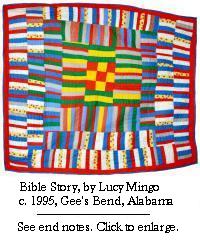 migration,
and really all aspects of quilt history. As a member of the Oregon
Quilt Project, I am now very interested in documentation.” migration,
and really all aspects of quilt history. As a member of the Oregon
Quilt Project, I am now very interested in documentation.”
6) What is your current “pet project”?
“I have a few. The Oregon
Quilt Project is one. I’ve been presenting talks, and will speak at
the Sisters, Oregon quilt show this summer during The Quilter’s
Affair. I’ve just organized my first exhibit, “Small Wonders: Doll
Quilts by Andrea Balosky” at the Latimer Quilt and Textile Center in Tillamook, Oregon. I’m working on my first museum exhibit, “Beauty
Secrets: 150 Years of History in One Quilt Pattern” to be held at
the Benton County Historical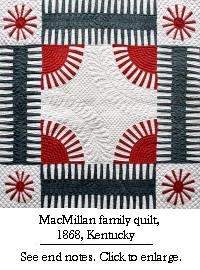 Museum in Philomath, Oregon, August 5th
through October 1st during Quilt County 2011. Both of those shows
come with self-published, full color catalogs, available through
Blurb (blurb.com). The Small Wonders catalog is currently available,
and the Beauty Secrets catalog will be available in August. Museum in Philomath, Oregon, August 5th
through October 1st during Quilt County 2011. Both of those shows
come with self-published, full color catalogs, available through
Blurb (blurb.com). The Small Wonders catalog is currently available,
and the Beauty Secrets catalog will be available in August.
"I’ve also continued to buy quilts. My recent acquisitions include
three best-of-kind, masterpiece "Rocky Mountain Road" aka “New York
Beauty” quilts from Kentucky, and a quilt made by Lucy Mingo of
Gee’s Bend, Alabama.”
7) What aspect of your research or contribution to textile
studies has satisfied you the most?
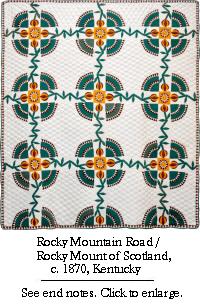
“The most satisfying project thus far was the subject of a virtual
poster presentation I did for the American Quilt Study Group, called
“Separated at Birth”. The research linked a masterpiece album quilt,
separated from its family history for many years, with another
family quilt discovered by the West Virginia Heritage Quilt Search.
My quilt, made by Mary Couchman Small in 1850, is the sister quilt
of another quilt made at the same time by Mary’s daughter, Harriett
Small. I’ve been invited to come to West Virginia in 2012, when the
two quilts will have a reunion of sorts."
8) Within this arena, what
would you like to do, but haven’t done
yet?
“Well, I’m really just getting started. In general, I would like to
bring American quilts to the rest of the world, teach younger
generations about American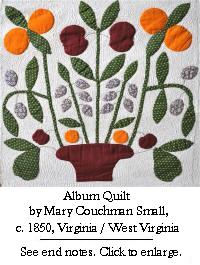 quilts, and help tell the story about
Oregon’s quilt heritage. On a broad scale, I’m especially interested
in using mass media to alter mainstream perceptions of old quilts.
In other words, academic papers will probably never be my preferred
method of communication. I’m much more likely to do a podcast, blog,
or documentary film.” quilts, and help tell the story about
Oregon’s quilt heritage. On a broad scale, I’m especially interested
in using mass media to alter mainstream perceptions of old quilts.
In other words, academic papers will probably never be my preferred
method of communication. I’m much more likely to do a podcast, blog,
or documentary film.”
9) Any further comments are invited.
“Most people are very surprised the first time they meet me. I don’t
fit the mold. I’ve arrived at guild meetings where I’m the
presenter, and have been greeted by people who probably thought I
was there to mow the lawn – “May I help you?” they say. When I start
talking about quilts, people will usually look at me as if to ask
how a guy like me knows about a subject like quilts. They don’t
expect words like “fussy-cut” to come out of the mouth of a guy
built like a football player.”
10) Please describe the contributions you have made via books,
exhibits, presentations, contests, articles, fabric lines, research
papers and the like.
“Beatuy
Secrets” a short documentary film (2009) – NW
Documentary
“Small
Wonders: Doll Quilts by Andrea Balosky” (2010) –
curator – catalog, self published through Blurb
“Quilts: A
Melting Pot” – selections from the Volckening Collection,
limited edition book, self-published through Blurb, soon available
in second edition.
“Separated
at Birth” my AQSG Virtual Poster Presentation
Wonkyworld Blog:
http://willywonkyquilts.blogspot.com
Web site:
http://www.billvolckening.com
Presentations from 2009 to
January 2011
New York Beauties
Columbia Willamette Quilt Study
Group, Eugene
Pioneer Quilters Unbroken Thread
Quilt Show, Eugene
Oregon Quilt Project with Martha Spark
Pioneer Quilters Show, Eugene
Guild Night Out, Sisters
Coburg Quilt Show, Coburg
Lebanon
The Oregon Garden, Silverton
- Six Masterpiece Quilts -
Northwest Quilters, Portland
- Good, Better, Best - OQP
Core Group Training, Eugene
- Separated at Birth - Tidal
Treasures Quilt and Fiber Art Festival, Tillamook
- The Julie Silber Connection -
Oregon Coastal Quilters Guild, Newport
- Four Signature Quilts -
Clark County Museum, Vancouver, WA
- Latimer Quilt & Textile Center
- Bed Turnings, Expo, Portland
- Red and Green Quilts -
Northwest Quilters, Portland
Upcoming in 2011
- NW Quilters
show in March,
- Sisters at The
Quilters Affair in July,
- Benton County
Historical Museum and NW Quilting Expo in September.
- Beauty Secrets: 150 Years
of History in One Quilt Pattern," Benton
County Historical Museum
Notes on the Pictures:
Rocky Mountain Road / Crown of Thorns, c. 1850, Kentucky
Rocky Mountain Road / Crown of Thorns, c. 1850, Kentucky. More
recently called a New York Beauty, this quilt features intricate
piecework and dense quilting. The red, green and white color
combination is indigenous to the civil war era. This quilt was part
of the 2001 Heritage of Genius exhibit in New York, and was featured
on the cover of the exhibit catalog. The quilt and a second quilt
were both on display in the Durst buildings in midtown Manhattan
from November through January 2002.
Bible Story, c. 1995 by Lucy
Mingo, Gee's Bend Alabama.
Lucy Mingo was a central figure in the
Freedom Quilting Bee and the Civil Rights movement. Among the quilt
makers of Gee's Bend her work stands out, but it is not as well
known because Mingo didn't always sign her own name on the backs of
her quilts. This quilt has the name of her daughter, Polly Raymond.
Through a stunning Facebook correspondence with original owner
Carolyn Mazloomi, Bill learned the quilt had indeed been made by
Mingo. The quilt sings and dances with pattern and color.
MacMillan family quilt, 1868, Kentucky.
This amazing quilt was among those discovered in the early
1980's by the Kentucky Quilt Project, the first statewide quilt
documentation survey. Elaborate piecework, curved seams, and lush
decorative quilting details make this quilt a true Kentucky
masterpiece. This iconic quilt, a recent acquisition by the
Volckening Collection, has traveled far and wide.
Rocky Mountain Road / Rocky Mount of Scotland, c. 1870, Kentucky.
Noted quilt dealer Stella Rubin included this rare example in an
advertisement that appeared in the Autumn / Winter 2010 issue of
Antiques and Fine Art Magazine. However, the quilt was snapped
before the magazines hit the newsstands. It is one of only a few
19th century examples displaying vines and pomegranates as sashing.
Album quilt by Mary Couchman Small, c. 1850, Virginia/West Virginia
This exceptional quilt was
separated from its family history for at least 15 years after it was
acquired by collector/dealer Sandra Mitchell in the last decade of
the 20th century. Elaborately quilted in rows of echo quilting at 11
stitches per inch and 1/16th of an inch separating rows, this quilt
could easily have a million quilting stitches.
Thank you Bill.
You are the first self-proclaimed quilt magnet I've met. I'm
guessing you have coined a term many quilt-lovers relate too. How
fun to hear your story. I look forward to seeing the multi-media
avenues of quilt expression you will bring to us as you continue to
magnetize other "Beauties" from the quilt world to you. Carry on and
may the wind be at your back! |